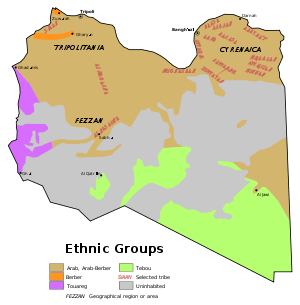Magarha
The Magarha (also al-Magarha, Meqariha) is one of the major Arab tribes of Libya. They originate from Fezzan province of Libya and have been an influential supporters and beneficiaries of Muammar Gaddafi during his long rule and then Libya's 2011 civil war.[2][3] Some Magarha have relocated to Sirte and elsewhere along the coast.[4]

After the Warfalla tribe which is Libya's largest,[2] the Magarha are Libya's second largest tribe with an estimated 1 million members.[5]
The Magarha, along with the Warfalla, have long formed an important alliance with Muammar Gaddafi,[2] with many Magarha located in the upper ranks of Libya's government and security forces. Abdullah Senussi, Muammar Gaddafi's brother-in-law and the chief of military intelligence, is a Magarha.[6]
History
The Magarha tribe has been semi-nomadic, and their alliances are mentioned in historical texts. The 14th century Islamic texts suggest that the Magarha were one of the tribes that controlled the oases and palm groves in the region that is contemporary west Libya.[7] Their rights were acknowledged in the 16th to 18th century Barbary Corsairs era.[8]
The historical records of the Ottoman Empire suggest that along with Riyyah tribe, the Magarha were Arab tribes of Wadi al-Shatti region, and that they supported the Ottoman's authority in Fezzan region.[9] In exchange for this support, the Ottoman Empire had exempted them from taxes, allowed them to collect a tribute from passing caravans and represented the Ottoman interests as its police force.[9]
Contemporary conflicts
Abdullah al-Senussi – the former Libyan intelligence chief, and Abdelbaset al-Megrahi – a Libyan officer convicted of the bombing of Pan Am Flight 103 over Lockerbie, were descendants of the Magarha tribe.[10][11]
See also
References
- Ali Abdullatif Ahmida (2011). Making of Modern Libya, The: State Formation, Colonization, and Resistance, Second Edition. State University of New York Press. p. 13. ISBN 978-1-4384-2893-2.
- M. Cherif Bassiouni (2013). Libya: From Repression to Revolution. Martinus Nijhoff. p. xxxiv, xlv, 811–812. ISBN 978-90-04-25735-1.
- Saskia van Genugten (2016). Libya in Western Foreign Policies, 1911–2011. Springer. p. 83. ISBN 978-1-137-48950-0.
- "Factbox: Libya's key cultural, tribal divisions". Reuters. Archived from the original on 16 July 2012. Retrieved 7 May 2011.
- "Gadhafi's rule relying on wavering tribal support". Associated Press. Retrieved 7 May 2011.
- "Analysis: Support for, opposition to, Gaddafi is tribal in nature". Homeland Security Newswire. Retrieved 7 May 2011.
- Ali Abdullatif Ahmida (2011). Making of Modern Libya, The: State Formation, Colonization, and Resistance, Second Edition. State University of New York Press. pp. 69–70. ISBN 978-1-4384-2893-2.
- McLachlan, K. S. (1978). "Tripoli and Tripolitania: Conflict and Cohesion during the Period of the Barbary Corsairs (1551-1850)". Transactions of the Institute of British Geographers. The Royal Geographical Society. 3 (3): 285–294. doi:10.2307/622157.
- Ali Abdullatif Ahmida (2011). Making of Modern Libya, The: State Formation, Colonization, and Resistance, Second Edition. State University of New York Press. pp. 54–56, 59. ISBN 978-1-4384-2893-2.
- Profile: Abdullah al-Senussi BBC News (16 October 2015)
- Obituary: Abdelbaset al-Megrahi, BBC News (May 20, 2012)
Bibliography
- Obeidi, Amal S M. Political Culture in Libya, Routledge, 2001.
- Ahmida, Ali Abdullatif. The Making of Modern Libya:State Formation, Colonization, and Resistance, 1830-1932, State University of New York Press, 2000.